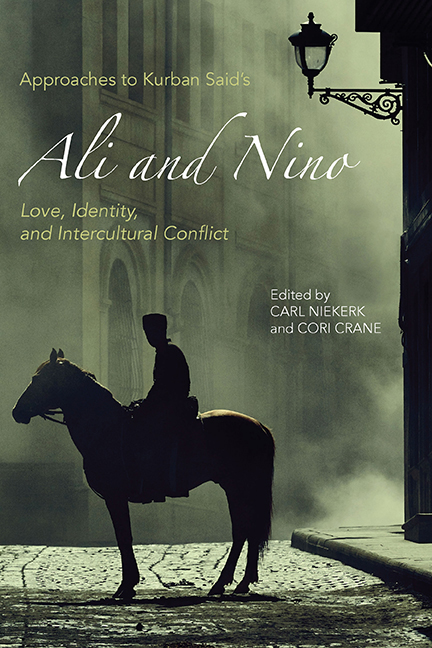Book contents
- Frontmatter
- Contents
- Acknowledgments
- Notes on Editions of and References to Ali and Nino
- Introduction: Ali and Nino as World Literature
- 1 Ali and Nino: The Novel as/of Cultural Translation
- 2 Crossing Borders, Crossing Disciplines: Ali and Nino in the Twenty-First Century
- 3 Glowing Rubies and Persian Daggers: The Role of Persian Poetry in Ali and Nino
- 4 Gendered Stereotypes and Cross-Cultural Moral Values through the Eyes of Kurban Said
- 5 Orientalist Itineraries: Cultural Hegemony, Gender, Race, and Religion in Ali and Nino
- 6 Gendered Conflicts in Muslim and Christian Cultures: Honor (and Shame) in Ali and Nino
- 7 Love and Politics: Retelling History in Ali and Nino and Artush and Zaur
- 8 “Herr Professor, Please: We'd Rather Stay in Asia”: Ali Khan Shirvanshir and the Spaces of Baku
- 9 The Female Body and the Seduction of Modernity in Ali and Nino
- 10 Seeing the Unseen: Symbolic Writing in Ali and Nino
- 11 Ali and Nino and Jewish Questions
- 12 Between Orientalism and Occidentalism: Culture, Identity, and the “Clash of Civilizations” in Ali and Nino
- Works Cited
- Notes on the Contributors
- Index
7 - Love and Politics: Retelling History in Ali and Nino and Artush and Zaur
Published online by Cambridge University Press: 30 August 2017
- Frontmatter
- Contents
- Acknowledgments
- Notes on Editions of and References to Ali and Nino
- Introduction: Ali and Nino as World Literature
- 1 Ali and Nino: The Novel as/of Cultural Translation
- 2 Crossing Borders, Crossing Disciplines: Ali and Nino in the Twenty-First Century
- 3 Glowing Rubies and Persian Daggers: The Role of Persian Poetry in Ali and Nino
- 4 Gendered Stereotypes and Cross-Cultural Moral Values through the Eyes of Kurban Said
- 5 Orientalist Itineraries: Cultural Hegemony, Gender, Race, and Religion in Ali and Nino
- 6 Gendered Conflicts in Muslim and Christian Cultures: Honor (and Shame) in Ali and Nino
- 7 Love and Politics: Retelling History in Ali and Nino and Artush and Zaur
- 8 “Herr Professor, Please: We'd Rather Stay in Asia”: Ali Khan Shirvanshir and the Spaces of Baku
- 9 The Female Body and the Seduction of Modernity in Ali and Nino
- 10 Seeing the Unseen: Symbolic Writing in Ali and Nino
- 11 Ali and Nino and Jewish Questions
- 12 Between Orientalism and Occidentalism: Culture, Identity, and the “Clash of Civilizations” in Ali and Nino
- Works Cited
- Notes on the Contributors
- Index
Summary
In memory of Rafiq Taği who was killed on the 23rd of November, 2011
SINCE ALI AND NINO WAS WRITTEN in German and for a German audience attracted by exotic and oriental settings, Kurban Said's book became well known in Western Europe. It took a much longer time for the book to get its place within the Azerbaijani canon of literature. Due to the international success of Ali and Nino, the book's reputation expanded in the eyes of Azerbaijani readers so that for them the book is now increasingly seen as the country's gift to world literature. Although elements of the story are influenced by classical Azeri and Persian literature such as Nizami's Layla and Majnun, the book and its author differ from other Azerbaijani prose and writers.
By leaving Azerbaijan and his Jewish heritage behind, subsequently converting to Islam and migrating to Germany, Lev Nussimbaum, or Kurban Said, himself becomes a colorful figure with a self-invented fictional dimension. In this sense, Nussimbaum has more in common with other struggling cultural Grenzgänger —like Swiss writer Isabelle Eberhardt, the English authors Richard Francis Burton, T. E. Lawrence, Aleister Crowley, and the Greek-Armenian Georges I. Gurdjieff—than with traditional and contemporary Azerbaijani authors such as Səməd Vurğun, Afaq Məsud, Anar, Kamal Abdulla, Rafiq Taği, and Elçin.
In particular, Nussimbaum's contemporary, Səməd Vurğun, is considered an important twentieth-century Azerbaijani writer. Through his folk poetry, which was tolerated by the Soviets, Vurğun (1906–56) shaped a nationalist Azeri literary language. Several monuments, streets, and public places in Azerbaijan recall Vurğun's importance. In addition to his prose, poetry, and dramas, he was also known for his affiliation with the Academy of Science in Baku (Azərbaycan Milli Elmlər Akademiyası). Just as it is today, it was not unusual in his time for Azerbaijani writers of the establishment to fill vacancies within the state's cultural and scientific institutions. Like Səməd Vurğun, Anar (born 1938) also occupied important positions in the state writers’ organization in the Soviet Republic of Azerbaijan. During the Communist reign, Anar was a typical representative of Socialist Realism. His most important work is Beşmərtəbəli evin altinci mərtəbəsi (The Sixth Floor of a House with Five Floors) from 1982.
- Type
- Chapter
- Information
- Approaches to Kurban Said's Ali and NinoLove, Identity, and Intercultural Conflict, pp. 135 - 151Publisher: Boydell & BrewerPrint publication year: 2017

